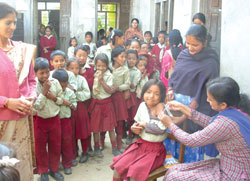|
|
| Girl students vaccinated for lifetime immunity against tetanus |
Young Dolmaya Gurung laughs as she gets an anti-tetanus vaccination shot. "It just tickles," says the eight-year-old at the head of a line of some 200 other girls from her Nepal Rastriya Secondary School, shirt sleeves rolled up and arms at the ready.
"Even children now know that vaccinations help prevent infections, especially tetanus," says Dolmaya's teacher Sabita Adhikari.
On Christmas Eve, the Ministry of Health and UNICEF concluded a three-week-long school vaccination programme that supplemented the national immunisation campaign and aimed to reach over a million children, especially girls between six and eight.
Tetanus isn't just something you can get by cutting yourself on a rusty strip of metal or a bad fall on a dirty street. In Nepal, this ordinary and curable disease remains an enormous problem, especially for new mothers and their babies. A large part of this is because there are simply not enough trained birth delivery attendants in most rural areas who can maintain the basic level of hygiene that rules out tetanus. The other part of the equation that can help reduce maternal mortality, says the Department of Heath, is immunising the mothers.
There is no reliable data about how many children and mothers die every year from tetanus-related complications, so the true magnitude of the problem is unknown. But rural health experts call it a silent killer, which takes lives even before the infection can be identified.
Close to 30,000 Nepali children die each year in the first month of their life, two-thirds of them in their first week. Neonatal tetanus is a major factor, since about 88 percent of babies are delivered at home without help from trained birth attendants, says the government]s Demographic Health Survey (DHS). A 2001 report by the national Health Management Information System, estimated the mortality rate from tetanus to be 2.3 per 1,000 live births, based on a study of 327 neonatal tetanus cases. Tetanus is one of the most under-reported health problems, so all figures are estimates only.
The realisation of the impact of tetanus on women and newborn health came late here, when Nepal was determined by international agencies including the WHO to be one of the 60 high-risk countries for maternal and neonatal tetanus.
"The only way to protect mothers through their childbearing years, and their newborns, is an aggressive immunisation drive that gives women five doses of tetanus toxoid in less than three years," says Bishnu Poudel, assistant project officer for immunisation programme of UNICEF. This is all it takes for a lifetime of protection against tetanus.
The current drive, which began in 2005, is one of the few in the world that targets school-age girls so they are immune to tetanus before they even reach reproductive age. The pilot project covered eight districts last year, and reached nearly 92 percent of students.
In 2005, maternal and neonatal tetanus (MNT) was declared 'eliminated' from Nepal by WHO. But that's not the same thing as eradication. MNT elimination is defined as the achievement of less than one MNT case for 1,000 live births in every district.
Unlike polio and small pox, tetanus can never be eradicated, as the spores are present in the environment.
The innovative program is already in trouble though. The planned expansion reached only three of the 16 districts planned for, due to delays in the Department of Health's procurement process for syringes.
A DoH source told us on condition of anonymity that the delay resulted from graft and disagreement about who to award the contract for medical supplies.
"As with all such problems, things like delays at the DoH can be counter-balanced by awareness programs too. The more the people know, the more careful they are," says Parsuram Shrestha, Bara's public health administrator, adding that local government health offices in the district are using their limited resources for this purpose too.



